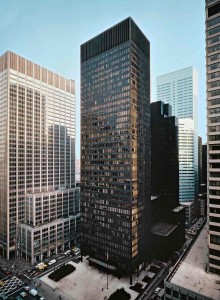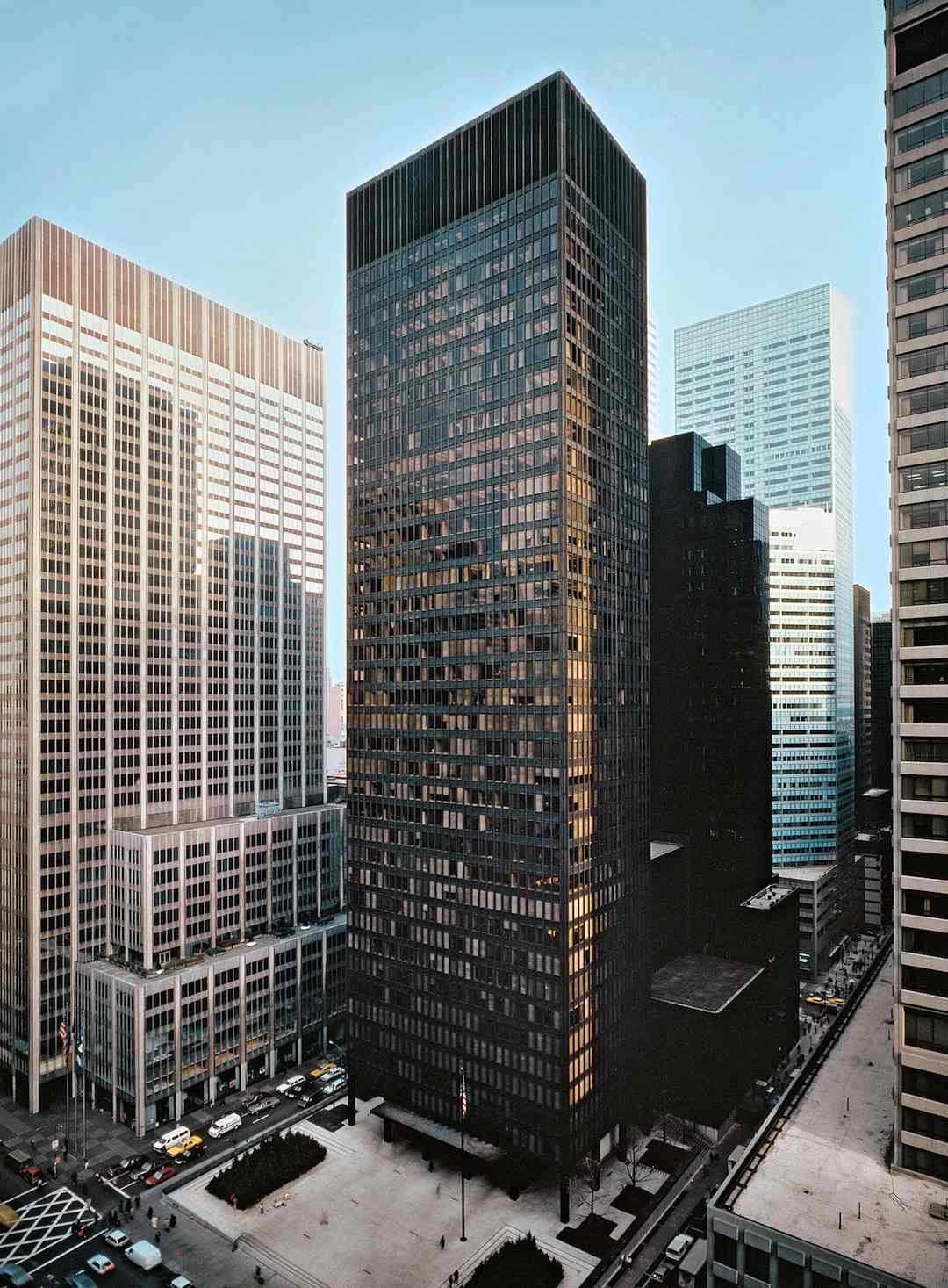 THE SEAGRAM BUILDING and I are about the same age, but as my hair continues to silver and the parentheses bracketing my mouth make me ever more parenthetical to the young, my favorite New York skyscraper never ages. As the exemplar of mid-century Modernism, Mies van der Rohe’s 38-story steel and glass edifice on Park Avenue is all about not showing its years (it was born in 1958). In referencing the agelessness of Bobby, the Peter Pan–like character in Stephen Sondheim’s Company, a lyric states: “You know what comes to mind every time I see him? The Seagram Building.”
THE SEAGRAM BUILDING and I are about the same age, but as my hair continues to silver and the parentheses bracketing my mouth make me ever more parenthetical to the young, my favorite New York skyscraper never ages. As the exemplar of mid-century Modernism, Mies van der Rohe’s 38-story steel and glass edifice on Park Avenue is all about not showing its years (it was born in 1958). In referencing the agelessness of Bobby, the Peter Pan–like character in Stephen Sondheim’s Company, a lyric states: “You know what comes to mind every time I see him? The Seagram Building.”
I am convinced that one reason many gay men adore the mid-century Modernist æsthetic is that, while its objects bespeak a certain era, those very furnishings and decorative objects are also meant to defy aging, to remain relevant and immune to becoming dated. While we seek and covet a distressed patina for an 18th-century Gustavian table or nurture the rust on a Victorian birdcage, we want that 1960s amoeba side table, Sputnik chandelier, and Danish Modern teakwood console to look as new as the day each emerged from its design studio, which is when most of us Baby Boomers emerged into the world. And like the ideal male form, mid-century Modernism is about straight lines, clean forms, handsome proportions, and an uncanny ability to fit in with any other æsthetic while also standing out.
Unlike any other skyscraper of or before its time, the Seagram Building did something daring, not unlike most artistically inclined gay men. Rather than conform to the line of the Park Avenue streetscape, with the facades of buildings aligned perfectly from the Met Life (née Pan Am) Building all the way to 96th Street, the Seagram steps back, in its case ninety feet from the street. To occupy the resulting plaza, reached via a series of broad, shallow steps and anchored by two stepped pools, is akin to walking on stage. As a longtime New Yorker, I feel a kind of exhilarating performance anxiety every time I course that space. To be on it is to be slightly raised above Manhattan, to occupy a plinth from which you can observe the controlled chaos of Park Avenue traffic. Upon it, you are amid Manhattan, a full-scale starring-role player in its vitality, but also slightly removed from it, enough so that you can observe the goings on all around. You can eavesdrop on the urban dialogue surrounding you, take in the action, and figure out which plot line you wish to pursue—all the while backdropped by the scenery of the building, which, at dusk, assumes a warm whiskey-bronze hue, served straight up. Nothing is ever out of place, for even the Venetian blinds are set in one of only three positions—up, down, or mid-way.
In fact, the Seagram Building has had a starring role in film. In The Best of Everything (1959), Joan Crawford plays a hard-boiled editor at a book publishing company, who high-heels it into the building and later terrifies her young staff with demands for punctuality and punctuation perfection. When her affair with a married man ends, she later returns to the office, proclaiming that, at forty, it’s too late to fall in love. Time to re-sharpen the red pencil. And in the movie version of Truman Capote’s Breakfast at Tiffany’s, Holly Golightly (Audrey Hepburn) is seen reposing in thought, knees pulled to her chest, on the building’s 53rd Street side green travertine ledge. On the eve of Holly’s departure from New York for a new life as a wife to her Brazilian playboy, this is where she goes to take in her departing visions of the city she loves.
So many of us gay men who come to New York as young men, right after college, want to be “That Boy!”—the counterpart to Marlo Thomas’ That Girl! We, too, fresh from the tarmac (though Marlo arrives by train), come seeking professional glory, love with a cute guy (she finds Donald), our own apartment, and immersion into the life of the Manhattan we dreamed about. That Girl begins her life in New York working at the magazine stand in the Seagram Building lobby.
The architect of record for the building is Mies van der Rohe, the Chicago-based, Bauhaus-trained, German-born designer, though (the gay) Philip Johnson had a pivotal role in its resulting form, particularly the lobby and adjoining Four Seasons restaurant. Although its future is now in jeopardy, the Four Seasons remains, for now, the most glamorous dining destination in town. A meal there begins, too, with a kind of stage-like entrance. Upon entering on 52nd Street, you pass a pair of real Barcelona chairs (to sit on one is to lose all of your change and keys), then ascend a broad staircase, whereupon you enter the Grill Room, the first of the restaurant’s two main spaces (the Pool Room, with its obvious decorative feature, is cited as social Siberia, though it is the more beautiful one). While auditioning for your table at the maître d’s podium, you can take in Johnson’s modernist masterpiece, a place always populated by some of the most powerful people operating in the world—regulars such as Henry Kissinger, Bill Clinton, Michael Korda, Anna Wintour.
Johnson himself used to eat lunch there almost every day. I remember finding him once standing by the Picasso tapestry, which used to adorn a transition space between the Pool and Grill rooms. I was still That Boy! then and was overwhelmed to see one of the world’s greatest designers and the man responsible for the space I was occupying. When I introduced myself and expressed my awe, I was naïve enough to be shocked by his— how to put this kindly?—prissiness. To be in such a vigorously male space, manly and Modern, an adult’s real-life Erector Set of I-beams and marble-strong walls, and to meet its maker, who unabashedly flirted with me (“You must have lunch with me next time you’re here”), was a surprise—akin to finding a gilded ivy scroll of Rococo ormolu above a support girder.
As a footnote to the 538-foot-tall building, when it arose on its site between 52nd and 53rd streets, just two blocks to the east was a notorious and thriving haunt of male prostitutes. I’ve seen vintage photos of the time that reveal the tawdry stretch of the street, loutish lads reclining on stoops, with the elegant lit profile of the Seagram looming behind, as if in judgment of that low-rent district.
Is it possible that a building can be a gay icon? Something that reflects our culture? And can a person have a crush on a skyscraper? Along that uninterrupted line of dowdy Park Avenue towers (except for the Pepsi-Co, Lever House, and the Waldorf-Astoria), the Seagram is the handsome man on the street. He’s the one that all other Modern skyscrapers look up to—trim, in shape, well-proportioned, groomed, inspiring. There have been countless clones of the Seagram in cities around the world, but none approaches its ageless elegance.
David Masello is a poet and cultural critic based in New York City.




